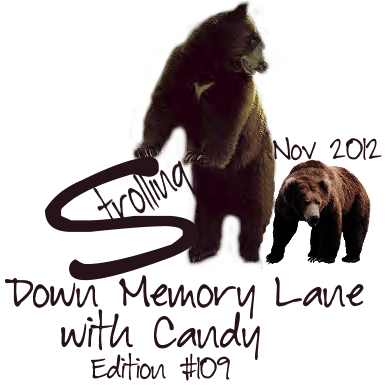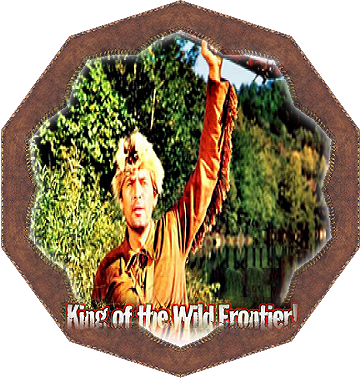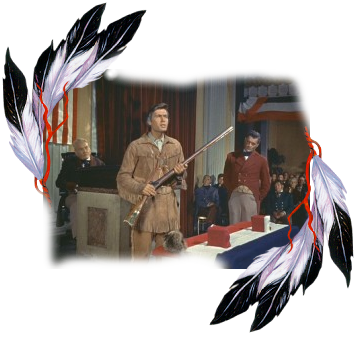

Walt Disney's cinematic treatment of the life of Davy Crockett was not properly a television series. It premiered in three separate, hour-long episodes of the Disneyland program: Davy Crockett, Indian Fighter was telecast on December 15, 1954, as the eighth installment in that influential Disney anthology show; Davy Crockett Goes to Congress appeared on January 26, 1955; and the trilogy ended on February 23 with Davy Crockett at the Alamo. No program before or since has captured the imagination of the nation in so short a period. Nielsen ratings placed the number of viewers of the second program at more than half of all people watching TV.
Before the finale was aired, the United States was gripped in a Davy Crockett craze. Crockett hysteria meant an unprecedented commercial boom. Spurred by youngsters and their faddish taste for the TV show, Americans spent upwards of $100 million in Davy Crockettry. More than 4 million copies of the record, "The Ballad of Davy Crockett," were sold; and 14 million Davy Crockett books were purchased.
"Born on a mountain top in Tennessee Greenest state in the Land of the Free Raised in the woods so's he knew every tree Kilt him a b'ar when he was only three. Davy, Davy Crockett, King of the wild frontier!"

Since Disney did not have exclusive control of the historic name and likeness of Crockett—as William Boyd and the estate of author Clarence E. Mulford possessed title to everything associated with Hopalong Cassidy—in short order there were an estimated 3,000 different Davy Crockett products for sale. From bath towels and plastic ice cream cone holders, to ukeleles, underwear, and wristwatches. Davy's name or familiar representation in fringed leather clothing and raccoon-skin cap triggered a consumerist binge.
The fad flourished about seven months, abating only when, as sociologist Paul Lazarsfeld reported at the time, "almost every child has his cap, rifle, powderhorn, book and record." Thus, when Disneyland offered two new Crockett TV films in late 1955—Davy Crockett's Keelboat Race (November 16), and Davy Crockett and the River Pirates (December 14)—millions watched but few were anxious to resume the merchandising mania.

In the history of the video Western the Davy Crockett programs were transitional. Although designed for children, they displayed adult values and relatively mature sensibilities. Certainly, Davy had familiar juvenile embellishments. His partner and pal, Georgie Russell, stayed with him from obscurity in backwoods Tennessee to death and immortality at the Alamo. His rifle was affectionately named "Old Betsy." Davy operated in a simplified world of black-and-white issues, and he possessed a moral mandate bordering on the sacrosanct.

But, Crockett also had grown-up qualities. The death of his wife lent bereavement and character-building vulnerability to Davy. He was also a patriot. Davy may have been familiar as a frontiersman in fringed buckskin clothing, but as a political philosopher he was uncommon—an unreconstructed democrat who was especially outspoken during his short career as a member of the U.S. House of Representatives.
In seeking elective office, he told his friend and fellow Tennessean, President Andrew Jackson, that if elected to Congress, "I wouldn't be takin' orders from you, General. I'd be takin' 'em from them that elected me." In Washington, Davy chided fellow congressmen eager to break treaties and grab valuable Indian land, telling them "Expansion ain't no excuse for persecutin' a whole part of our people because their skins is red and they're uneducated to our ways." With plenty of backwoods allusions, he reminded them—and contemporary Americans as well—that running the nation, indeed even being part of the nation, was serious business. As he phrased it, "We got a responsibility to this strappin', fun-lovin', britches-bustin' young b’ar cub of a country," Davy declared with noble innocence, "We've got a responsibility to help it grow into the kinda nation the
Good Lord meant it to be."

Long before the so-called adult Western premiered in the fall of 1955, the Davy Crockett features illustrated the potential impact of mature Westerns on viewers. Walt Disney later suggested a causal relationship between these films and adult cowboy dramas. As he told an interviewer, "I gave ABC their first full-hour Western series with my Davy Crockett shows and soon the network was flooded with other Westerns.”
While Disney may not have been accurate in that assessment of his impact on television—The Life and Legend of Wyatt Earp was in production before the Crockett fad swept the nation—the Davy Crockett phenomenon could not have helped but impress TV producers and network executives.
While I may have been too young to remember the first airings of the show, I sure do remember seeing them over and over as they were rebroadcast. Sometimes in an old movie or tv show I will see the youngsters wearing that coon skin cap and I know why and it's somehow comforting. I think today's kids miss out on the simple things, nowadays they won't settle for a cap they want the $100 video game based on the show or movie as they sit inside on their computers or in front of their tv's. I remember my brother had the coon's skins cap and the rifle too and he was never inside the house...him and his gang of neighborhood kids were off to an adventure that I couldn't wait to be old enough to go on...
think about that next time you buy your kids or grand kids a video game.
I know you can still get the series on Amazon...and here's a quote that might motivate you, (they even have the costume, I just checked!)
Chief Red Stick: Why you no kill me?
Davy Crockett: Maybe because of another law. We have trouble living up to it, but it ain't bad for red man or white man: thou shall not kill.
Nuff said....see you next time.

Strolling Down Memory Lane With Candy - Main Page